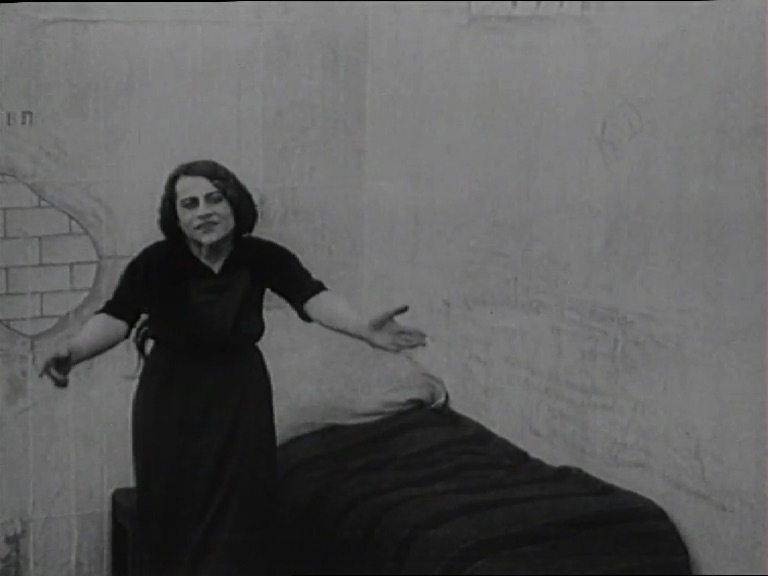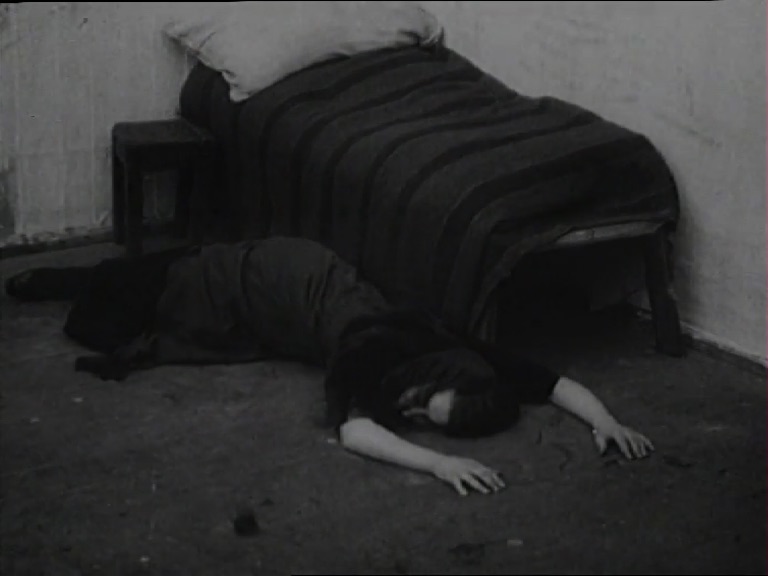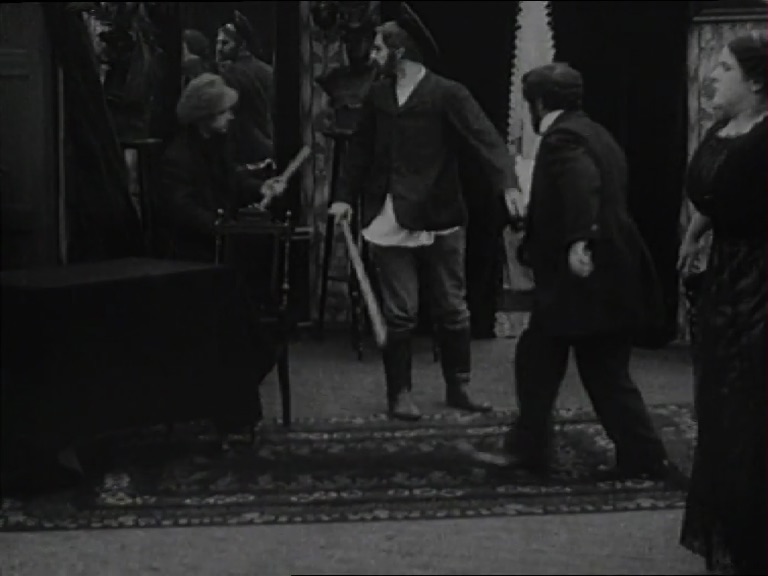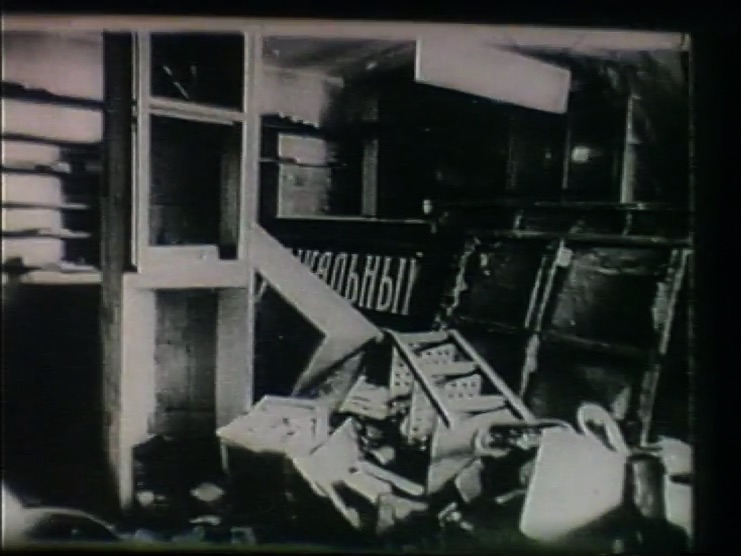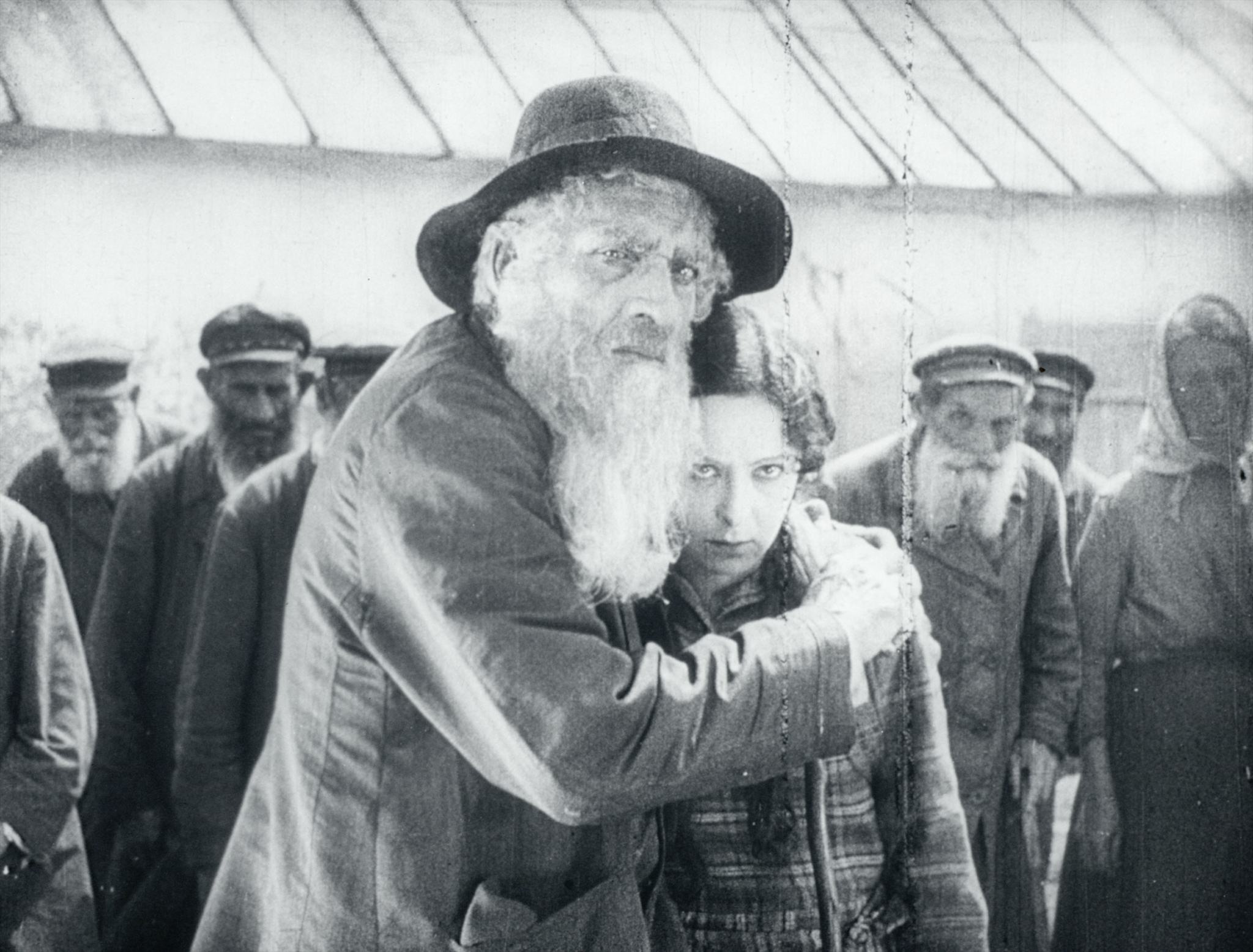Introduction
First Images of Pogroms on Imperial Screens: a Conscious Transgression
Information or Pedagogy: Two Productions from the Russian Civil War
Representation of Pogroms in Cinema during the 1920s
Five Brides: The Pogrom in a Time of Melodrama – New Version
Conclusion
Introduction
The memory of anti-Jewish violence has always been a source of inspiration for Jewish artists. Evoking the crimes, their description, their denunciation, their lamentation would unfold in poems, stories, plays, paintings, drawings, sculpture of various kinds, with degrees of directness of the references ranging from the very explicit to the most allusive.1 A latecomer among the art forms, the cinema endorsed this aim of perpetuating memory. However, its immediate portrayal of the lived world proved a natural catalyst in leading to debates about the appropriateness of showing violence on screen: the idea of a “criminogenic cinema” that encourages its viewers to reproduce the actions seen has been a leitmotif since the initial appearance of the animated image in various countries.2
In the Russian Empire, Jews were subject to persecution periodically accompanied by the unleashing of extreme violence, particularly in the late 19th century – and until the downfall of the Tsarist regime. The issue of how to represent this violence was made particularly acute by the position assumed by the authorities, who would typically gloss over the abuses, or even pass over them in silence entirely. The Revolution’s aftermath and the radical changes in the status of the Jews, which it had spelled out, were followed by decisive shifts in the way the cinematographic medium treated Jewish history; it now became possible to evoke anti-Jewish violence on screen. The case of the attacks dating from the Russian Civil War after the Bolsheviks’ coming to power, raised the question in a new way. In the present article we analyze the film productions bearing on this development; by limiting our study to the first decade of Soviet cinema, we will zero in on a period of time in immediate proximity to the perpetration of the violence. The present study will be placed in a triple context: that of the image of the Russian Civil War in general as created on Soviet screens, and this image’s evolution; that of the image of pogroms and anti-Jewish violence in films produced before the Revolution; and that of the image of the same anti-Jewish violence during the years following the period the present study considers. Finally, contrasting the cinematographic with the way in which anti-Jewish violence was treated by other media will enable an appreciation of the specificities of the language of film. We will thus focus on a history of representation, rather than one of memory strictly speaking, even if memory was in fact being targeted by the filmmakers we discuss, as well as was emergent among the public (in at least some of the cases). However, we will not limit ourselves to analyzing images; we will also focus on the effect which they produced. While it is still difficult to evaluate reception by the general public, contemporary reactions of the various censors and professional critics offer an indication of how these films were understood and promoted, or, conversely, of how they were denounced and sometimes even banned in a shifting political and social context, which also depended, as we will see, on the location where the films were screened.
The collection of materials studied in this article includes a number of films preserved in their entirety. Many others are incomplete reels, sometimes cut off by censorship, sometimes difficult to access and available only in Gosfilmofond or other archives of Russia and others of the former Soviet Republics. The primary sources and documents which might help shed further light upon them are most of the time extremely limited: elements of censorship files, in cases when such files were actually kept (such as release authorizations or minutes of meetings of various commissions ruling on the films), along with some press articles and advertisements. To this we have added information about unpreserved movies, as well as script projects never turned into works for the screen.3
In cinematic representations of the civil war, Soviet cinemagoers were typically treated to images of cavalry boldly charging. Indeed, the dominant genre representing this historical period is the adventure film, led to prominence after the success of the serial Krasnie diavoliata (Red Young Devils, Ivan Perestiani, 1923) produced by Goskinprom in Georgia. Cavalcade imagery is a hallmark of a great many films, the most famous of which are Chapaev (G. and S. Vassiliev, 1934) and Shchors (Alexander Dovjenko, 1939).4 The adventure genre resurfaced as late as the 1960s with Neulovimye mstiteli (The Elusive Avengers, Edmond Keosajan, 1968), a remake of Red Young Devils. In some cases, the use of equestrian fighter imagery went beyond application in adventure films pure and simple: melodrama mixes in to achieve an ideological purpose or to register particular sensitivity for the psychological; occasionally, scenarios emphasizing the political vacillations or divisions among the protagonists are stamped with extensive use of the same type of imagery, as well. Members of the same family, fathers and sons, siblings with opposite fates, married couples or lovers, as in The 41st (Jakov Protazanov, 1927), and even professional collectives (the traveling circus in 2 Bouldi 2 by Lev Koulechov, 1929, or in Posledniy attraktsion by Olga Preobrazhenskaja and Ivan Pravov, 1929), are divided by their allegiance to or against the Reds.5
This made films depicting the suffering of civilians, and of Jewish civilians in particular, rare in movies produced in the 1920s. When excesses committed by Red Army soldiers are dramatized – especially the armed extortions and looting – it is made clear that the perpetrators are recent recruits and politically dubious elements. Moreover, their actions are usually shown as directed against bankers or wealthy (Jewish) merchants; they are therefore to be basically understood as restoring a form of social justice (Benja Krik, Vladimir Vil'ner, 1926).6 But most of the time, violence shown in these movies is committed against the soldiers of the Red Army or their proven supporters by the Whites (Buhta smerti, Abram Room, 1926), occasionally by atamans (Tripol'skaja tragedija, Alexander Anoshchenko, 1926; Veter, Lev Sheffer, Czeslaw Sabinski, 1926), or, more rarely, by Makhno troops (Surovye dni, Alexander Shtrizhak, 1933). The violence is always graphically represented. The perpetrators are particularly sadistic and bestial, and the sophisticated forms of torture they resort to are shown in atrocious detail. In the discussion that these films provoked, both cinema professionals and politicians spoke out against “blood on the screen.”7 There was no consensus on this, however; Budennyj, for one, argued that “the naturalistic representation of blood, murders, and other horrors, was perfectly admissible and even necessary, if it managed to emphasize the revolutionary idea of the film.” Even so, he admitted that the line between a “naturalistic presentation” and an “ostensible exhibition” was difficult to draw.
By the 1930s, the Russian Civil War had been assigned a central role in the founding myth of the Soviet State; ever greater attention was being lavished upon it by means of the cinematic medium.8 Several films focus on heroes with a plebeian background, at times inspired by historical figures (Chapaev and Shchors) and purely fictional at others (Podrugi, Leo Arnshtam, 1935; My iz Kronstadta, Efim Dzigan, 1936; Vsadniki, Igor Savchenko, 1939).9 Scenarios increasingly emphasized the importance of the role played by the political leaders of the emerging Soviet state, while their enemies are typically represented as enjoying support from abroad (provided by the Poles, the English, the French or the Germans, depending on the time and the place of action).10 The growing schematization of both narrative and character types, as well as the total disappearance in the 1930s of attempts to represent the political diversity which marked the period before the triumph of the Bolsheviks,11 and the reduction of national or ethnic differences to strict social divisions, spelled out the complete obliteration of the singularity of the Jewish experience during the Russian Civil War. Only one narrative was now legitimate, which cast workers and poor peasants as taking the side of the Reds while the bourgeois and the big landlords supported their enemies. Finally, as Denise Youngblood argues, with war movies as a genre emerging in the 1930s, the key protagonists in these productions are fighters, while civilian experience is reduced to providing the backdrop for the fighters’ exploits.
This explains why the works discussed in the following pages are extremely few in number. The few fictional elements with an explicit reference to pogroms committed during the years of the Russian Civil War appeared as part of campaigns launched against antisemitism either during the civil war itself or subsequently in the late 1920s.12 They were all subject to orders that the pogroms represented on screen must not be attributable to the Reds; Red action was to be represented as nothing other than irreproachable. Vis-a-vis the Soviet audience, the purpose is therefore to deflect possible charges of responsibility for any abuses by assigning all blame to the enemies of the new regime.
There are two additional reasons for the scantiness of material available for our study: the first is the work of active censorship, while the second is a result of the loss of filmic sources.13 The extent of the cuts imposed by censors’ committees can sometimes be appreciated based on surviving documentation. Whether implicit or openly expressed, the prohibition against representations of physical degradation on screen is a considerable obstacle to any evoking of the pogroms. Prior to the Revolution, quite besides the widespread disapproval of portrayals of violence, the reality was that to mention the pogroms meant to question the imperial order of things. After 1917, as we shall see, the reasons given for the prohibition against bringing up the pogroms remained, in essence, the same as during the years before the Bolshevik takeover.
We purpose here to study the various strategies resorted to in order to circumvent such obstacles, in chronological order from the 1910s to the end of the 1920s. Analyzing the way in which pogroms were represented in a few pre-Revolutionary films will form a prerequisite for this, as these works had a formative impact on both professional moviemakers and the movie going public. During the revolutionary period, filmmaking was supposed to serve a pedagogical purpose: the goal was not only to denounce anti-Revolutionary violence, but also to justify the Soviet policy of integrating the Jews into the new social order. Ten years later, filmic reminders of the abuses committed between 1918 and 1920 were assessed as educational tools within a context shaped by a resurgence of antisemitism.
BACK
First Images of Pogroms on Imperial Screens: a Conscious Transgression
Among the many issues impacting the life of Jews in the Russian Empire from 1910 onwards,14 violence perpetrated against civilians is only rarely taken up as a cinematographic focus, since making a choice of this kind ran the risk of having the film banned from screens or even destroyed. There was no explicit rule defining pogroms as taboo topics, and censorship, then in local hands, was very inconsistently exercised; its norms varied considerably from one region to another. Nevertheless, it was made clear that police authorities would look with disfavor upon any open representation of the abuses, which had elicited no intervention on behalf of the victims; in fact, the abuses were occasionally given the authorities’ approval. Vu iz emes? (“Where is the truth?”), a movie directed by Simon Mintus in Riga in 1913, forms a striking exception to this general pattern. Based on a play by the prolific and popular author Abraham Shomer, the film is a melodrama with a plot directly addressing the fate of Russian Jews.
A young Jewish female student is spotted by policemen, who order her to leave Riga as per the laws restricting Jews’ right to reside in the larger imperial cities. To circumvent this, the young woman registers as a prostitute. Falsely accused of theft, she is next sent to prison. There, in her cell, she rummages through her series of obsessive mental associations. A scene from her childhood, an idyllic flashback, comes first: as a little girl, she receives a gift from her father and goes out with for a walk with the maid. At the end of this first vision, the heroine is once again in her cell. The camera follows her as she collapses on her bed, burying her head in a pillow.
She next seems brutally pulled up erect, as if by an inner force, to face the camera, a picture of fright: a new vision, this time nightmarish, again takes the viewer to the young woman’s past. We return to the cozy family apartment, the mother, the maid, and the child, all frightened and hiding in a corner of the living room while the father rushes to the door. He is pushed aside by two men wearing boots and workmen's caps and armed with clubs. They burst into the apartment, followed by more intruders who rudely seize whatever strikes their fancy; lighting upon a bottle of liquor, they unceremoniously drink up. A cushion is thrown on the floor, and the mother is forced down upon it by one of the men. The father attempts to intervene, but is beaten and collapses. The vision ends with a superimposition that gradually focuses on a close-up of the young heroine’s face in the grip of terror. As the vision fades, chaos continues to reign in the apartment where her father is being searched, while another assailant throws furniture around. The traumatic scene dates back to the Kishinev pogrom of 1903, in which the young woman lost her parents; the reminiscence ends as she collapses onto the floor of her cell.
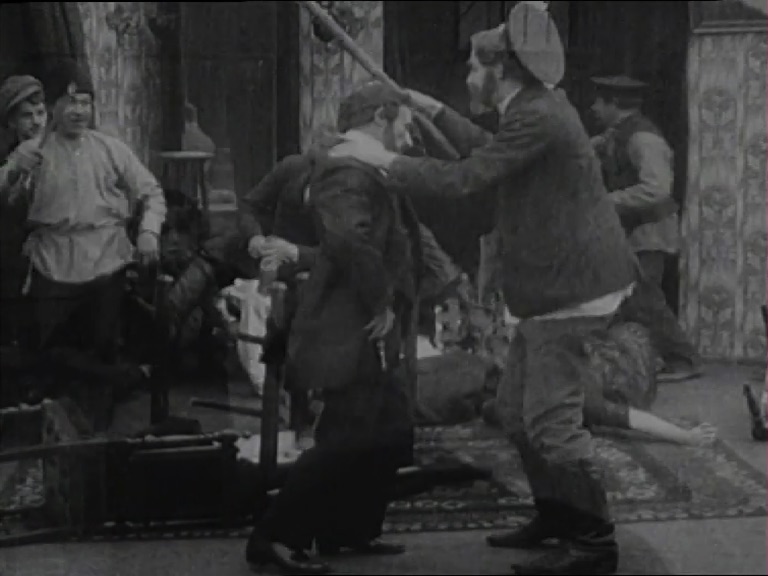
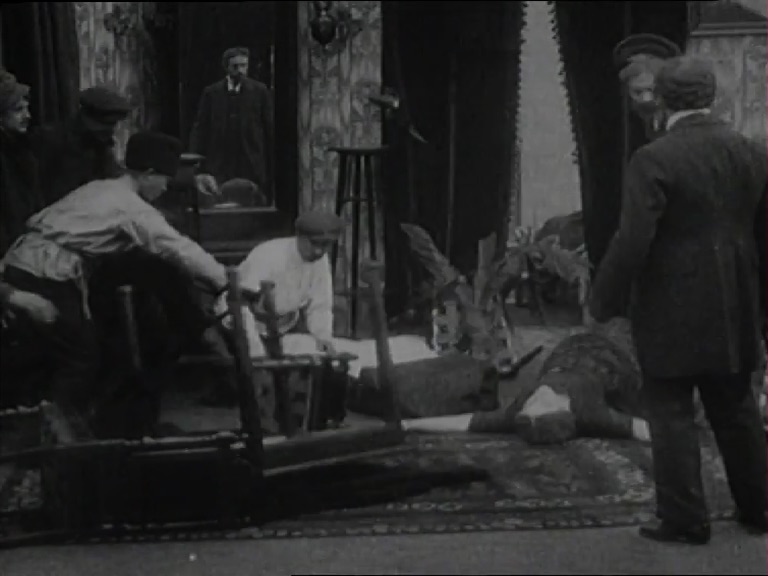
As the film progresses, the police realize that a mistake has been made: the real culprits are identified, and the commissioner gives the order to release the heroine, to the delight of her fiancé, also a young Jewish student. But the trauma she has gone through proves too much for the young woman; succumbing to her nightmares, she dies shortly after being set free. In an exceptional manner, this film centers on the pogrom as the central event which determines the fate of the heroine: neither the rule of law, ultimately triumphant, nor love can affect the trauma or its aftermath.
According to Yuri Tsivian, a historian of the cinema who collected parallel material on the same work in the 1990s, the film publisher was reported to have presented the authorities with a carefully edited version of the movie’s most daring scenes.15 The film had apparently had some success; it went through a remake the same year in Odessa, which unfortunately has not been preserved.16 Most important, it seems to have created a model and a precedent. Indeed, the viewer cannot but be struck by the similarity between it and the pogrom scene in V ikh krovi my ne povinny (We Are Not Guilty of Shedding Their Blood), directed by Mikhail Bonch-Tomashevskij after the February Revolution of 1917. Here, too, we see men wearing boots and armed with clubs breaking into a bourgeois interior and attacking the inhabitants. In Bonch-Tomashevskij’s work, the victim is the heroine, Sima, a revolutionary. The political dimension, absent in the film of 1913, is central to the movie by Bonch-Tomashevskij which hovers, in terms of genre, between political indoctrination and melodrama. At an early point in the plot, the revolutionary hesitates between two suitors, a Zionist and a Democrat. The film is an adaptation of the play Evrei (The Jews) written by Evgenij Chirikov in 1904 in response to the Kishinev pogrom; the play was immediately banned by censors. The Revolution of February 1917 made film adaptations possible. Unlike the incarcerated heroine of Vu iz emes?, Sima is not passive: her family manages to escape, but she remains, in opposition to the attackers. She not only faces the pogromists ransacking the house, but shoots at them before turning her revolver on herself. Her two suitors are reconciled to each other and promise to fight against the Black Hundreds. The heroine starts out as a victim, to turn into an active protagonist who offers resistance to the violence; she prefers to kill herself rather than submit. But it is the struggle against antisemitism that becomes the key among intensifying political tensions, a layout about to change drastically. The film is typical of the period between February 1917-late 1919. The removal of all restrictions against the Jews of the Russian Empire opened the way to abundant cinematographic creations depicting the disrupted lives, humiliation, extortion, and false accusations suffered by the Jews. At least two of the new works place the pogroms of the beginning of the century at the center of their stories.
Despite their paucity, cinematic representations of pogroms dating from the imperial era had a powerful impact, providing a major reference point for years to come, even though the number of victims caused by the events which they describe was considerably lower than during the civil war years.17
BACK
Information or Pedagogy: Two Productions from the Russian Civil War
Innumerable obstacles stood in the way of the two reels of 1919-1920 and their portrayal of ongoing pogroms; their filming and preservation was an achievement against near impossible odds. The first is a documentary edited in Berlin; the second, a work of historical fiction by Ermoliev Studio, was commissioned by the Moscow Film Committee. The former is very explicit in its treatment of its subject; the latter merely evokes a pogrom scene, possibly the outcome of undocumented censorship or other interference of which we at present know nothing for certain.
The documentary, titled Les pogroms juifs en Ukraine 1919-1920, is a trilogy, of which the first two parts repeat, with some variations, the same images we are already familiar with from other works; it is accompanied by French and then English subtitles. A series of stills and recordings convey the monstrous aftermath of pogroms in various localities in Ukraine: destroyed stores and homes, streets filled with debris, scattered papers, pieces and shards of broken things; disfigured corpses, bodies which relatives have difficulty recognizing, in the cemetery, having been excavated from the bottom of the river or wells where they had been thrown; ransacked synagogues, desecrated Torah scrolls; the violence breaks out anew in every screen. The effect is intentional: the work clearly aims to shock. The headings, generally more detailed in English than in French, specify the places, the dates, the numbers of victims, and, often, the perpetrators. The images form a sequence so as to span the territory of Ukraine (including both small towns and larger cities), as well as the spectrum of types of victims: eminent representatives of the community, famous rabbis, wealthy merchants, renowned intellectuals – along with anonymous figures, especially children, teenagers, and elderly men. Remarkably, the fate of women remains invisible: all documented cases show figures of men. Identified pogromists hail from each of the many sides involved in the Russian Civil War, with the notable exception of the Bolsheviks: all organized armed forces – those of the UNR, the Poles, and the Whites; the best-known insurgents, including Struk, Zelenyj, and Grigoriev; and unnamed groups lumped together as “insurgent peasants.” The third and the shortest part of the trilogy shows survivors receiving treatment at makeshift relief centers.
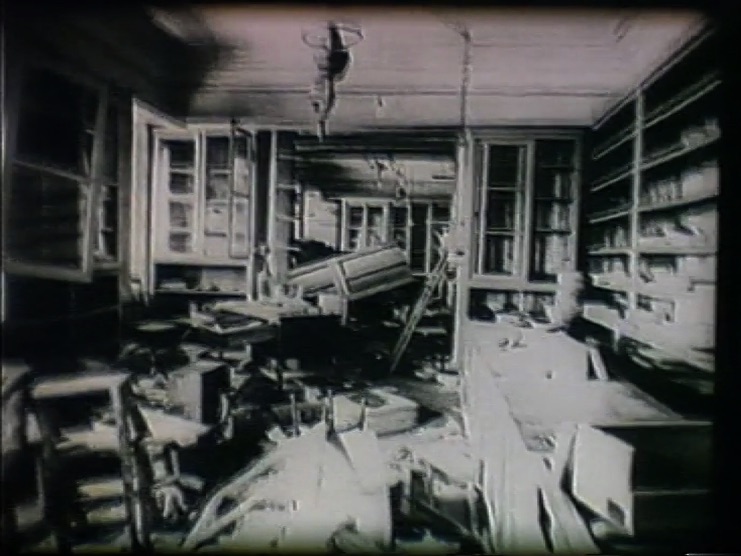
Russian State Film and Photo Archive at Krasnogorsk (RGAKFD), film n°13964
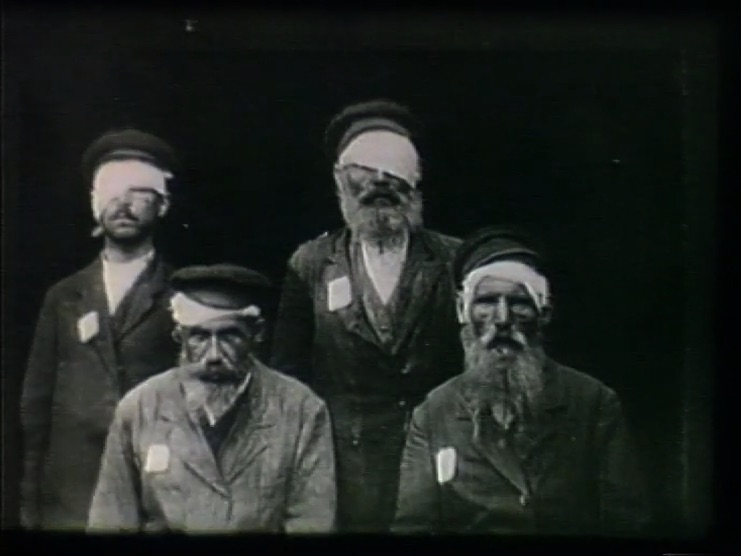
Russian State Film and Photo Archive at Krasnogorsk (RGAKFD), film n°13964
Archival evidence indicates that the photographs (as well as probably shots of scenes) included in the documentary were provided by the Kiev Aid Committee to Assist Victims of Pogroms (Kiev Evobkom), whose Information Department not only collected written testimonies, but also promoted visual documentation.18 The editing, according to the opening credits, was done by the Historical Archives of Ukrainian Jews in Berlin.
The Ostjüdisches Historisches Archiv must be meant, coordinated by Elias Tcherikower, historian, writer, and journalist, himself a native of Ukraine. Tcherikower systematically collected testimony and documents on pogroms from 1919, building upon the work of several relief associations, such as the Evobkom. From 1920 onwards, with Bolshevik rule extended to Ukraine following a series of military successes, the Evobkom began to operate under the auspices of the recently created Soviet relief organization stationed in Moscow and having a pan-Ukrainian regional base. Part of Tcherikower’s collection was secretly transferred to Berlin when with many of the Evobkom relief workers opted for exile. Even so, limited collaboration between the two committees continued.19 This explains why none of the violence documented in the film is traceable to the Reds. The documentary’s preservation in RGAKFD, the Russian state movie archives, is further evidence of cooperation between Berlin and Moscow. The documentary was probably meant to raise awareness on an international level, perhaps among politicians in the United States, the United Kingdom, and France (and possibly elsewhere), as well as to raise funds for victim relief. However, the montage may also have been assembled later, for use in the defense of Samuel (Sholem) Schwartzbard, the murderer of Petliura, whose trial opened in October 1927 in Paris; the documents for the defense were, in fact, provided by Tcherikower. If true, this would explain the French-language headings.20
Very different from this is Tovarishch Abram (Comrade Abram, Alexander Razumnyi, 1919), an “agitation film” (agitfilm) produced as part of a campaign against antisemitism.21 Like most of the works dating from this period of scarcity, the movie is brief (less than twenty minutes) and the story, extremely simple, targets an uneducated public probably made up of Red Army soldiers. The didactic aim is twofold: to demonstrate, by means of a concrete example, the senselessness of anti-Jewish prejudice, and to arouse feelings of compassion and admiration. The hero is a Jewish man, a victim of violence rescued by a Red officer. The Jew ultimately integrates into the new society created by the Revolution thanks to that, unlike Tsarist times, he now enjoys the trust of the authorities, and also because pro-Soviet citizens sympathize with his suffering and offer him their material and moral support.
The film begins during the First World War, showing the effects of antisemitic propaganda circulated by the reactionary press. Novoe vremia, a contemporary periodical, flashes its updates: Jews are suspected of collaboration with the enemy; some are arrested. One Egorov, a soldier, injured in a skirmish on the outskirts of a town, crawls to the nearest house, where he is ushered in and taken care of by Abram and his family. After he recovers, the Russian Egorov comes upon a leaflet accusing Jews of treason. He crumples the paper into a ball to throw it away. A meeting of the Black Hundreds proceeds on screen as if to shed light on the origins of the antisemitic propaganda. A lacuna in the narrative follows due to the incompleteness of the preserved copy (kept at Gosfilmofond). We next see Abram stealing away from a bivouac in the woods. We find out that he has been victimized (he is "one of the persecuted"). He manages to reach the railway station where he unexpectedly meets Egorov, whom he tells that his family has been annihilated during a pogrom. The pro-Bolshevik soldier convinces him to join him on the train. Once in Moscow, he helps Abram find a place to live and a job. Shortly thereafter, the young Jew addresses fellow factory workers with a summons to enlist in the Red Army. He soon finds himself at the head of a volunteer battalion. Despite being underequipped, his unit routs the Whites, taking some of them prisoner. Abram is held up as an example. The film ends with a military parade showing off volunteers become disciplined soldiers, united around their Jewish leader.22
The film is punctuated with some explicit pronouncements: “I’ve suffered double, as a worker and as a Jew,” and, further, “They’ve killed my family! I will never give up.” All this achieves a reduction of the principal message to a few simple statements for the viewer to internalize. Even so, some ambiguity remains.
To begin with, the condition of the film reel does not permit dating the pogrom with any degree of precision: did the anti-Jewish violence it refers to take place during the First World War or during the Russian Civil War? It is also impossible to ascertain whether the original version of the movie actually included explicit pogrom episodes, or whether it was the original intent of the author to make an elision. Censorship indisputably accounts for the fate of many works in later years, but in the case of this movie director, who was active prior to 1917, it is clear that he had fully internalized the message concerning images of physical violence.
Besides questions raised by the lacunae in the story, which remain indeterminate as to whether they were voluntarily made or imposed, Comrade Abram is thoroughly typical of the ambiguity inherent in the Soviet campaign. Though it is undertaken to eradicate antisemitism in the army and among civilians and addresses primarily the working classes, the campaign can never criticize actions committed by those whom it addresses. The antisemites are always the others; in the case of this movie, they are the Whites, the representatives and supporters of the ancien régime, the former Black Hundreds in accord with a definition to be adhered to in later years: antisemitism is the counter-revolution.
The way pogroms were treated on screen was informed, both explicitly and not, by several factors; primary among these were the locus of production (within or without the Tsarist Empire’s bounds, in the new Soviet State then taking shape), and the target audience. Given the current state of the sources, it is very difficult to assess the circulation and impact of the two films. The lack of a list of original headings makes it impossible to detail the pogrom cited in Comrade Abram. The preserved version is probably from a screening copy, after some parts had been cut. Cuts could well have been made to prevent the spread of toxic ideas. This consideration often played a decisive role in the work of the censors during the 1920s.
The impact which the political context of the anti-pogroms campaign had upon films such as Comrade Abram is obvious. But this does not mean that the makers of these films had been directly solicited by the authorities. In addition to the urgency of preserving testimony or preventing crime, more opportunistic considerations may have played a role for some of the filmmakers. Die Gezeichneten (Karl Theodor Dreyer, 1921-22), centering on anti-Jewish violence on the eve of 1905, and another, more laconically titled work, Pogrom, are examples. Das Geheimnis des Beilis Prozesses (G. Fredall – pseudonym used by Alfred Halm – 1919) went through distribution in the USSR under the title Pogrom.23 The existence of a potential audience may be the explanation.
BACK
Representation of Pogroms in Cinema during the 1920s
The initial drive to elide Red-perpetrated pogroms metamorphoses gradually into glorifying the Russian Civil War; mention of Jewish suffering endured simply insofar as the victims were Jews becomes impossible. Tripilska tragediia (Alexander Anoshchenko, 1926), inspired by real events, recounts the last hours of a group of young Red partisans murdered along with Red Army soldiers by a band of Ataman Zeleny’s (Danilo Terpilo). What the film fails to indicate is the antisemitic aim of the massacre.24 Any hint about pogroms is confined to the dramatization of events which took place either during the First World War or, more frequently, earlier in the first years of the century.
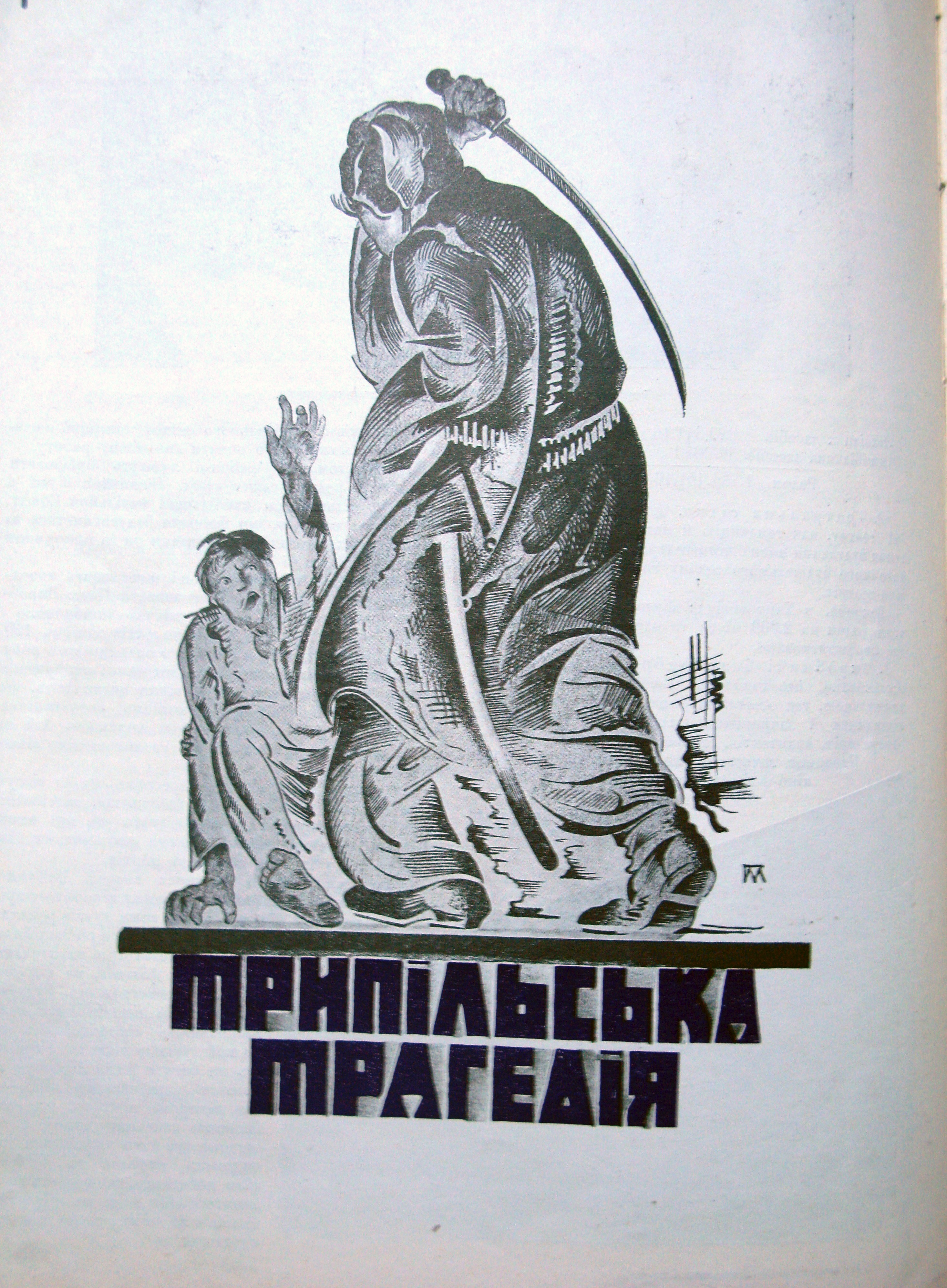
Oleksandr Dovzhenko National Center (Kyiv)
A project which never advanced beyond the planning stages was part of Eisenstein’s work on what would eventually become Battleship Potemkin (1925). The essential question was clearly this: how to dramatize the turmoil in 1905 Odessa without bringing up the attendant pogrom? In the original script, the seventh act was in its entirety devoted to the devastation wreaked by the pogrom. The director had prepared a cut-out of 65 shots, which, in a style reminiscent of the Grand Guignol, featured, in terrifying detail, scenes of rape and massacres of Jewish refugees in synagogue or theatre buildings which are ultimately torched. Some of the details aimed to produce shock: one sequence showed a stabbing of a victim who lies on a bed and whose blood seeps through the mattress, dripping on the children in hiding under it. Later, a funeral procession is attacked by the Black Hundreds and scatters in panic. As part of the commotion, a coffin was supposed to yawn open, spewing out the body onto the ground. As we know, however, the director ultimately narrowed his focus to the single episode of the sailors’ rebellion; ideas about ways to evoke the pogrom remained among the many unrealized projects of the author.25
It is difficult to know which of these visual concoctions were meant to provoke disgust and fear in the audience, and what belongs to the genre of the Grand Guignol, but may not have been possible to film as such. At about the same time, Eisenstein denounced his colleague Abram Room’s penchant for the pathological in his first film, Gonka za samogonkoi (The Warlord's Run, 1925).26 One year later, Room was criticized for overly graphic torture sequences in his Buhta smerti (Bay of Death, 1926), and had to exculpate his work in writing.27 In literature, several contemporary writers resorted to crude portrayals of anti-Jewish violence. However, following David Roskies, we should note that preference for this particular kind of bloody, macabre, grotesque excess remained limited. No film seems to have opted to work in this direction.
One filmic work, unfortunately not preserved, which centers on the pogrom is Mabl (Evgenij Ivanov-Barkov, 1927), based on a story by Sholem Aleikhem. Some of the exteriors were filmed in Vinnitsa in Ukraine. The shooting of the pogrom sequence, in the summer of 1926, provoked further violence when the Cossacks on set, who had been recruited for the purpose, without plan or rehearsal, rushed to beat up the Slav extras in Jewish costume. The region’s pogroms of less than 10 years previously had evidently left their mark, and the work had trouble passing censorship. It was reworked several times before being found satisfactory. For example, only poor Jews were to be targeted by the Black Hundreds, while bourgeois families were to be spared, a requirement which resulted in a number of cuts. In a similar vein, the movie was to demonstrate class solidarity, so that any help granted to the victims had to originate with Russian or Ukrainian workers.28 Finally, the pogrom scene had to be made significantly shorter because, according to the censor, the film was otherwise “likely to arouse anti-Jewish reactions in some of the population.”
What bothered the censors seemed ultimately a contradiction: on the one hand, the Jewish dimension was overly prominent (specific gesturing, transcription of Yiddish speech in the intertitles, overly obvious “Jewish physiognomies” in the units mobilized for self-defense); yet, on the other hand, the film allegedly failed to make the spectator feel that “Jews had died for the Revolution.” The required alterations listed number in the dozens: views of the shtetl and scenes of Jewish life were to be “interspersed with others, showing the revolutionary movement sweeping across Russia,” in order not to “create the impression that the Revolution of 1905 [was] mainly the work of Jews.” It was also preferable to make it clear that Tsarist police had come to the aid of the pogromists, and more along the same lines. This diversity of censors' opinions can be chalked up to their sheer numbers: the film was assessed by an enlarged commission comprised, in addition to the principal directory committee (Glavrepertkom, the head censorship organization charged with issues of the cinema), of members of the Head Committee for Political Enlightenment (Glavpolitprosvet) of the People's Commissariat for Education, the OGPU, and the Jewish Section of the Party Central Committee (Evsektsiia), all in the presence of the filmmaking studio reps. Hence the wealth of feedback reflected in the archival documents: from a “clearly antisemitic film to be permanently banned,” to “a few modifications [will be] sufficient to enable distribution for the film, which has already cost 260,000 rubles.” Proceeding laboriously in steps, the film was gradually transformed to suit these multiple requirements; it finally came out on screens in April 1927.29 However, stages of the editing process were not documented, making it impossible in retrospect to detail the cuts and additions made in the course of the nearly 12-month-long re-working.
Contrary to what these initial difficulties may suggest, the film received extensive coverage in the press, the media’s attention buoyed by the fact that actors of the renowned Habima played the main characters. Critical opinion, however, was divided: while Sovetskij ekran praised the director's tact in scenes of violence, Pravda regretted that the kaleidoscopic effect of the scenario precluded a holistic understanding of the events.30 Given the many cuts made and the film’s success, the director, who had been forced to eliminate multiple scenes from the overly complex scenario, was confident he could create a second film based on the material remaining.31 Most likely thanks to the fact that it was never permitted a public screening, this work has in fact reached us intact. The title, Protiv voli otsov (Against the Will of the Fathers), directs attention to the family as the setting of the central conflict: between the revolutionary young generation and the parents. Two fathers belonging to the older generation, one choosing assimilation, the other upholding tradition, balance out the youth. As in Mabl, a pogrom strikes, but, unlike Mabl, no one is spared. The simple folk and the two bourgeois in the area – the traditionalist merchant and the assimilated pharmacist – share the same fate. This is one reason, but not the only one, why this second film was banned.32
The pogrom sequence – unseen, let us emphasize, by any spectator at the time – is thoroughly striking. It is divided into several micro-scenes intertwined by parallel editing to suggest the simultaneity of the violence in several places in the town. Men wielding clubs attack stores and storages on the ground floor of a large building; others attack a woman (who is shown lying on her back, suggesting public rape). Elsewhere a gang of young pogromists try to drown several people at once. Finally, the pharmacist – smartly dressed and dignified-looking – is singled out in the street and mocked (including by very young children), harassed, forced to undress, and eventually abandoned in his shirt and underwear. By contrast with censors’ demands about Mabl, this time there were no insistent requirements about including Tsarist police who support the pogromists, nor about Russians helping the Jewish victims. The entire Jewish community was targeted without class distinction.
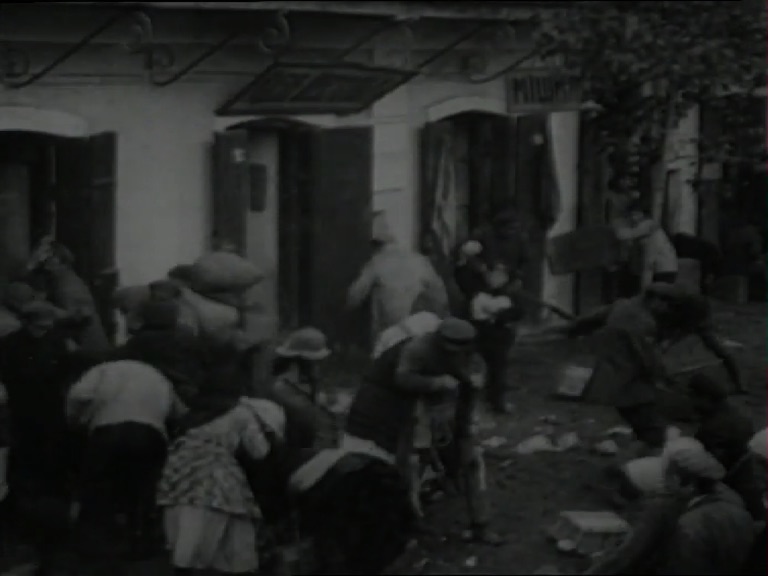
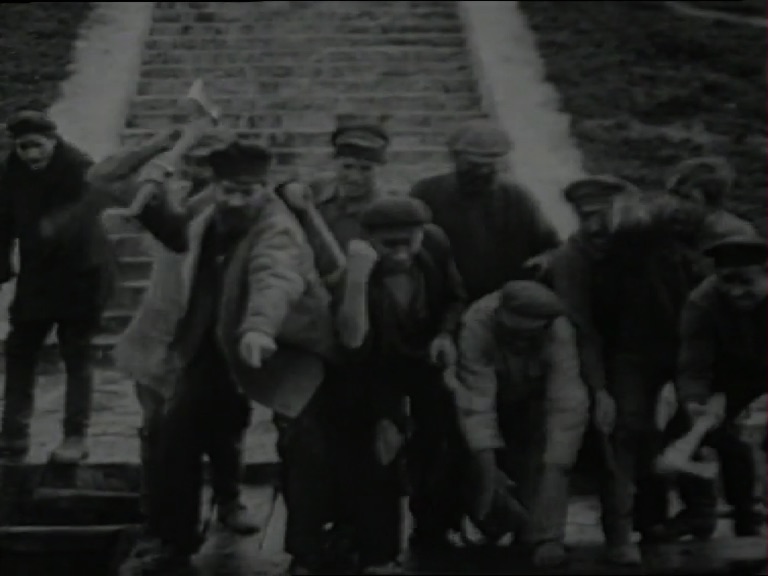
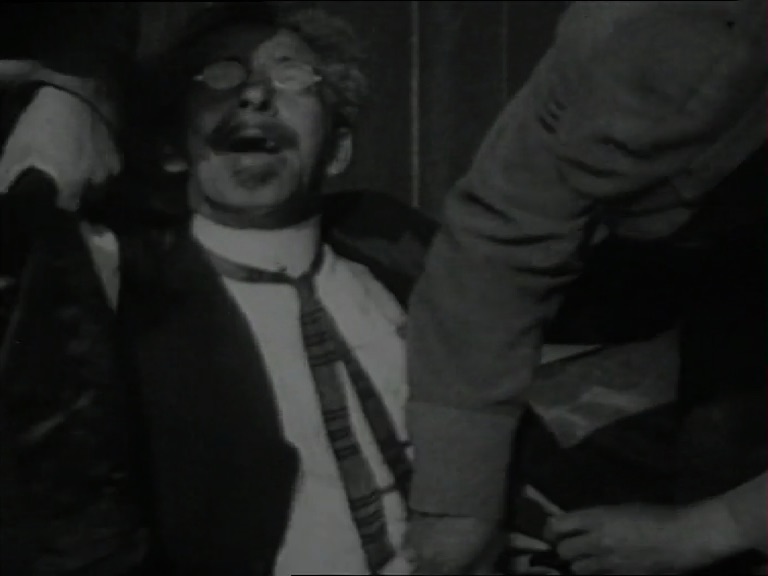
The stipulation that only the poor suffer from the pogrom, while the rich take advantage of protection by the police, is, unlike these earlier movies, respected in Glaza, kotorye videli (Eyes That Have Seen, Vladimir Vil'ner, 1928), a Ukrainian film originally titled Motele the Idealist. In this work, a contrast is from the outset focused on between the fates of two Jewish families of the imperial era: the rich family exploits the other and forces its daughter into marriage. The declaration of war in 1914 serves to deepen family cleavages: the son of the bourgeois family is exempted from military service and his father succeeds in doing business with the military, while the poor family is expelled from the territories close to the front, its property is stolen, and the family members are finally killed in a pogrom. The film passed Ukrainian censorship without any major difficulty, but met with some misgivings among the critics concerned about the wealth of clichés and the exaggerated melodrama.33 Russian censorship, unlike the Ukrainian, demanded the suppression of several scenes, especially the pogrom sequence, and “all those that could make the Jews pass for victims.”34 The film came out a year later in the RSFSR and was criticized for “nationalism” and the absence of any sense of class solidarity between Jews and non-Jews.35 But once again, no copy seems to have survived and the historical references in the pogrom scenes in the original version (before the cuts) remain a puzzle.
It has been observed that, while the issue of anti-Jewish violence disappeared from the news in the first half of the 1920s, it returned to prominence with the launch of the campaign against antisemitism later in the decade.36 Very few films dared refer to current events making the headlines at the time (assassinations, assaults, humiliations). Filmmakers preferred to take on pogroms from the early years of the century, on the eve of the First World War, avoiding any overlap with the chronology of the Soviet State, which now dated, retrospectively, from the aftermath of October 1917. Even so, censorship was not content with violence displayed on the screen, particularly in the RSFSR. If not targeting the working class as a whole, pogroms on screen would have at least to target the oppressed while sparing the rich. Cinematographic focus on the singularity of the fate of the Jews met with a mixed response: some censors, sensitive to widespread antisemitic sentiment, feared the perverse effect of such images; others branded the depicting of Jews as victims as “nationalist.” Suppressing scenes of anti-Jewish violence was accordingly called for; memory of the pogroms was to be erased.
BACK
Five Brides: The Pogrom in a Time of Melodrama – New Version
Against the backdrop of this overall dearth of material, Piat nevest (Five Brides), made in 1929 in Odessa by the Ukrainian studio VUFKU, forms a remarkable exception: not only is violence against the Jews during the Russian Civil War the key concern, but the pogrom is also at the center of the film’s action. The scene of anxious waiting as the violence is about to break out takes up an entire reel, an approximate 10 of the movie’s 60-minute total; unfortunately, this is also incompletely preserved. Others of the pogrom scenes show abuse, threats, intimidation, and humiliation. The exteriors were filmed in a shtetl in southern Russia, where the director enlisted locals for enhanced realism – a widespread practice – in addition to the few well-known actors with assigned roles.37 The story is a perfectly conventional melodrama. It has something of the fairy tale about it: terrifying at first, but with a miraculous ending. The part played by a mysterious character, a kind of Jewish God’s fool in the town, with an unknowable power over the unfolding of events, intensifies the sense of the supernatural. The tension between documentary aspirations and fiction is made further poignant by a cinematography marked by expressionism with its angles, framing, and contrasts. The work as a whole surprises with its mix of heterogeneous elements and unusual mood.
A shtetl is threatened by a band of insurgents supporting Petliura. The wealthiest of the townsfolk flee, evacuating their families and property, while the young people who are left behind try to arm themselves and seek out the “Red partisans.” A well-to-do Jew advises them against this, telling them to listen to the rebbe instead. He dwells on the danger in reaching out to the Reds; the synagogue and religion are the only possible source of protection. In the street, an old woman brings a meal to her son who, lacking a shoemaker’s shop, works outdoors. She sits in front of him, watching him eat, while a man warns of the imminent arrival of the Petliurists. Two cavalrymen ride into the main street. Their faces appear in close-ups: Cossack moustaches and shaved heads with topknots, followed by the pacific face of the old woman as she sits knitting. She smiles at one of the Cossacks, then stops knitting, stands up, and tightens her headscarf in front of the camera. The following shot frames the Cossack’s heel spurring the horse. The camera then seems to move backwards and finishes by narrowing its frame to the woman’s knitting as it rolls in the dust. The son stands up, a laconic question conveying his sense of horror and revolt: “For what?” The Cossack gallops off, the picture of a threat against the entire shtetl. The locals panic, and the camera captures the confusion as if itself caught in the chaos. Only the young pro-Reds remain, while the shoemaker stands motionless beside his trampled mother’s body.
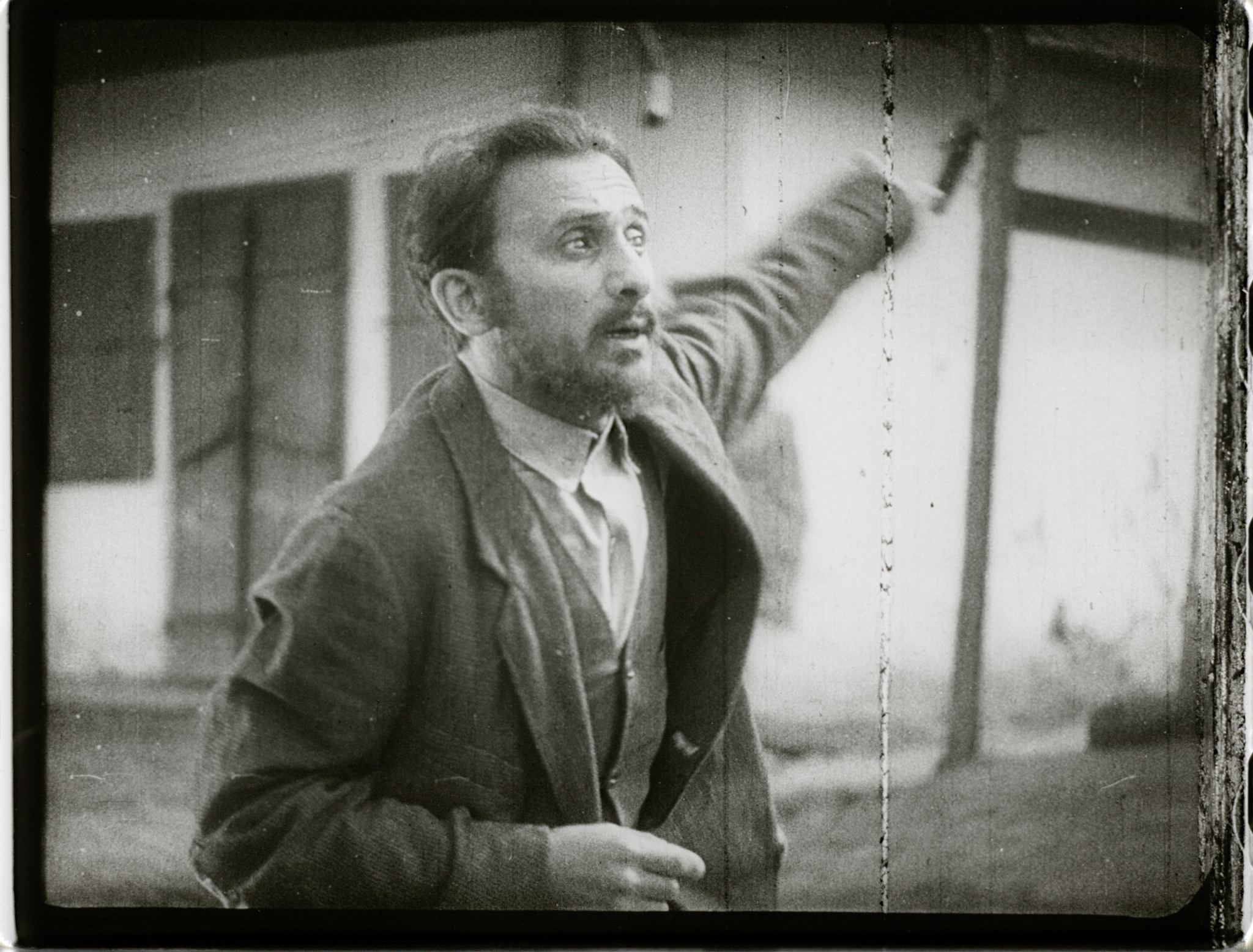
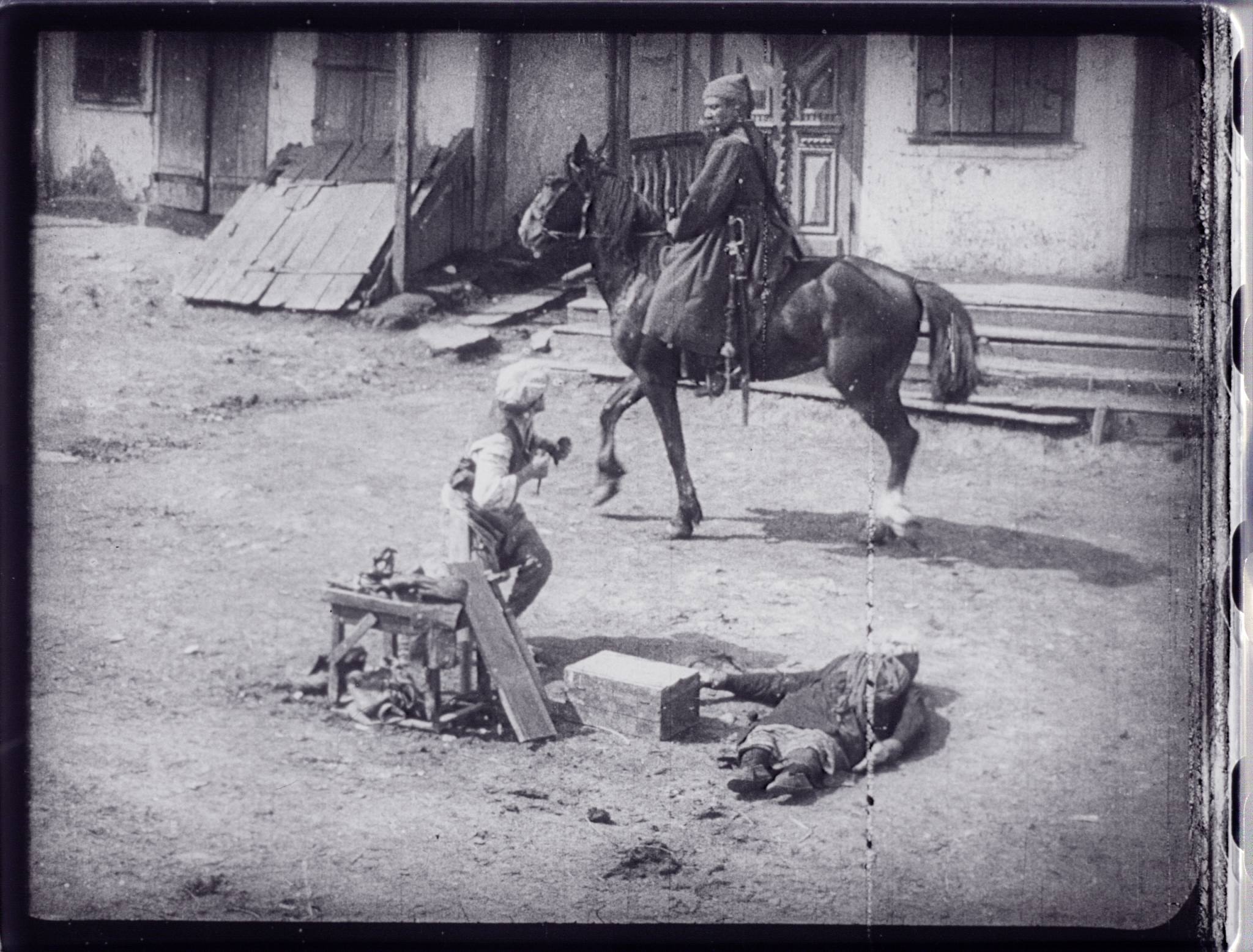
This powerful opening scene and the choice of framing and camera movements make the spectator identify with the victims, the frenetic camera mirroring the confusion of bodies. The rest of the film is marked by anguished waiting cut in multiple planes, diagonally or with high-angle shots, showing people alone or in small groups holed up in empty houses, attics, and huts. The sequence accomplishes a shift from the spatial continuity of outdoor scenes at the beginning to the unresolved fragmentation of dark interiors. The process is very effective in the way it transmits the sense of loss of the mainstays of life and the collapse of all that is familiar and reliable. A brief scene shows an old blind woman abandoned by her children when she proves unable to run for shelter. She faces the camera, her arms outstretched, begging not to be abandoned. There is no follow up detailing the old woman’s fate, but also no grounds for harboring idyllic illusion.
The film’s main character, Leiser (played by Amvrosij Buchma), a traditional long-bearded Jew, seeks to protect his daughter (Tamara Adelgeim); he seems to wield some authority in the community.
The Cossacks communicate to him their chief’s demand: 5 virgins are to be handed over if the shtetl wants to be spared. After a long hesitation, the community finally agrees. The film then loses itself in heated debates over which young women are to be given up, the reactions of their parents (especially Leiser, whose daughter is to lead the group), and preparations for their departure. A young man wants to rebel, but is silenced by three rich Jews who advocate submissiveness: they choke him under their prayer shawls. The second murder of the movie is thus committed by the Jews themselves. The unmooring of the shtetl’s values and, more generally, the collapse of a community confronted with the threat of violence is in perfect conformity with the Marxist scheme. This order of proceeding may well have been inspired by works of literature.38 The scene of the meal in the ceremonies hall, in which the ataman and four of his henchmen are brought together with the five young women decked out in bride’s dress triggers wild camera sequences as the Cossacks give in to the effect of their drink. (“Their heads are turning,” in a literal sense). Fortunately, a group of young people has managed to alert the Red partisans, who launch an operation to save the shtetl. The end, which most likely included the Reds’ intervention and some fighting scenes, has been lost. The last surviving image shows the saviors arriving on galloping horses.
The film seems to have seamlessly passed censorship in Ukraine. A mixed review in the press complained that it fails to explain the social roots of antisemitism, falling into the trap of unrelieved sentimentality, as well as that the portrayal of the pogromists is too much of a caricature. The author of the review argued that the action overwhelms the analysis, with the most significant result being that part of the audience would be contented with a dose of strong emotion and proceed to go home on “an empty head.” The film would thus fail in its role as part of the campaign against antisemitism. The review also noted the paradoxical effect of a poorly crafted scenario: on the one hand, prayer is shown to be bootless, and Leiser clearly becomes convinced that “God does not exist”; yet on the other hand, the partisans arrive at the very moment when this is made manifest, thus providing vibrant proof to the contrary.39
Problems arose at the RSFSR censorship committee meeting. A first series of reworkings was apparently ordered, but the archives only preserve minutes of the deliberations which took place after the second showing to the censorship committee.40 Chief objections concerned the total absence of the Party and the Red Army (the partisans intervening only in the closing scenes like a deus ex machina); the fact that the shtetl is entirely inhabited by Jews, and the meager attention devoted to class conflict; the fact that the community gathers inside the synagogue; and, last but not least, the “erotic” element. The screenwriter and the director were called in to exculpate themselves. They explained that they had intentionally avoided showing the pogrom in progress: “We were told: no physical horror on the screen.” We are given to understand that it was this requirement that had led them to develop the implausible plot of the five hostages. The authors also attempted to defend themselves against the charge of political feebleness: the division between the rich and the poor was made obvious, as was the complicity of the rich and religious authority, which made them accept compromises; the poor youth, by contrast, sided spontaneously with the Reds. Finally, they explained that the synagogue was, in addition to its purely religious function, the place of meeting for the Jews as a community and that Leiser was not a rabbi, contrary to impressions the censorship committee had based solely on his long beard and broad-brimmed hat. All this notwithstanding, the authors had to come up with an alternative version, shortening several scenes and adding captions to others to prevent misleading interpretation of the kind undesirable from the censors’ point of view. In the new version, Leiser, an authority in the shtetl, supporter of the youth, and father of one of the five brides, becomes a malicious character, under the sway of the authority of the rabbi and the community’s wealthy: he is now cast as “socially hostile,” as per the demand of the censorship commission. The film was detained in Moscow through late November 1930.
Only then were premiere screenings organized for the press, culminating a few days later in a ban on the film. An article co-signed by seven worker correspondents demanded its immediate withdrawal; the same demand was promptly echoed by two film critics.41 The most sensitive point was the plight of the young women given up as the price for saving the shtetl: this served only to “distract the proletarian audience from the immediate objectives of class struggle.” It had also obviously been dictated by the clear intention of “inciting erotic emotions, thus proving extremely harmful,” the critics asserted. Other critics argued that “instead of fighting antisemitism,” the film cultivates “an antisemitic state of mind.”
These objections, published after the release of the film, give expression to the same thinking that, intentionally or not, also motivated the censors, shaping the way pogroms were represented on screen. As we have noted, the need to recast ethnic-cultural differences as social class distinctions in order to promote class solidarity, along with the must of casting the Red Army – and the Party – in the role of saviors leading the struggle against antisemitism, accounted for the direction moviemaking took. We might also note the explicit prohibition against showing violence on screen.
The sum total of all these contradictions made Five Brides the only film produced in the USSR to put Russian Civil War pogroms at the heart of its plot. Clearly enough, openly violent scenes were discarded; thus, the dead body of the old woman is only shown using a long shot. Prior to this, the close-up of her knitting is both a synecdoche and a symbol of the pogrom overall; it also avoids any open display of physical degradation. Similar tactfulness comes to the fore later on: the camera spins, leaving the audience to guess about the violence or the rape of the young women prior to the arrival of the famous “Red partisans” on the scene. To the best of my knowledge, this is also the only film that dramatizes, however indirectly, on screen the staggeringly widespread occurrence of rape during the Russian Civil War. Remarkable, too, is the attention devoted to scenes of panic, confusion, anguish, and civilian distress. This is no triviality in Soviet cinema, especially insofar as these images, in a move uncharacteristic of the period, imply no stigmatization. By contrast, figures of the frightened bourgeois fleeing the arrival of the Reds or hiding behind doors and windows in their posh homes are a topos of Russian Civil War moviemaking.
Five Brides was far from a sweeping success. This may be attributed to the need to fulfill a double injunction: to satisfy the requirements of the campaign against antisemitism, but without falling into the didacticism of obvious and explicit propaganda. VUFKU’s commercial orientation probably dictated the choice of subject and the melodramatic genre. Despite the mix and the unresolved tensions, the criticism voiced at the time that the film fostered antisemitism – the pretext for this being that the film develops an erotic dimension by tracing the lusting gazes the Cossacks direct toward young women – seems today very exaggerated. The position of the authors on this was unequivocal, made obvious by the clear empathizing of the camera with the victims as it translates their experience through its movements and oblique frames. The film is one of the rare attempts of the period to combine the achievements of the avant-garde in cinematography with a social concern extending beyond a narrow political program. At the same time, and speaking up in defense against their Muscovite censors’ objections, the authors respect the version of history dictated from above in the late 1920s: the shtetl’s Jewish bourgeois murder the young man who tries to intervene to save young women from pogromists; a complicity is clearly indicated between the two groups.
BACK
Conclusion
Pre-1917 Russian cinema and Soviet cinema are alike in that both retain a marginal memory of pogroms; the anti-Jewish traces of the Russian Civil War are even less evident. The filmmaking rather celebrates the most glorious episodes of a history presented with ever growing insistence in the mode of an epic saga. Pogroms against the Jews are relegated to a remote period to avoid any synchronization with the history of the revolutionary movement and the birth of the Soviet State. The only film to center its action on the pogroms was ultimately not distributed in the RSFSR, and its only surviving copy, incomplete, is the version released in Ukraine; this, incidentally, probably makes it closest to the original. For many years, the subject disappeared from screens. In the mid-1960s, Alexander Askoldov's attempt to adapt “In the City of Berdichev,” a 1934 story by Vassili Grossman set during the Russian Civil War, led him to shift the plot’s anti-Jewish violence to a different period: that of the Holocaust, a topic which had recently circulated in the news but was entirely taboo for cinematic representation. Askoldov’s film was banned. Among the leading criticisms, the filmmaker was charged with connecting antisemitism and the origins of the Revolution.42 Apart from the couplet ditty by Buba Kastorskij,43 a cabaret artist in the Elusive Avengers, which was released in 1967, it was only after the end of the Soviet era that this subject regained legitimacy. The song by Kastorskii (words by Emil Radov, performed by Boris Sichin) enjoyed remarkable popularity. However, the performance was by a comic artist (comic, at least, on stage), and the tragic import of the subject was not seized upon by the public.
We should not for all that imagine an audience of cinemagoers and critics unanimous in their unquestioning acceptance of these avoidances, injunctions, cuts, and rewrites. A number of reports went so far as to note the sense of lacunae in the works. One critic was surprised that Motele the Idealist (released in Russia with the title Eyes That Have Seen) does not include a pogrom scene even though the subject is extensively discussed at the beginning of the movie.44 Another critic saw the Jewish bourgeois and Tsarist officers as utter caricature: “the bourgeois are obligatorily ugly, frightful, constantly gorging themselves. Officers rise and fall into decay. The falsity of such an interpretation is particularly striking in a film that is otherwise relatively subtle and ambitious.” 45
All in all, pogrom scenes remained marginal. If, in the 1910s, they were an obvious transgression, after the Revolution they were confined to a very few films in total. From 1917 on, it became appropriate to decry violence against the Jews, but uncovered distance still separated denunciation from actual depiction. There were several reasons for this: first, the representation of physical degradation was widely regarded as inconvenient. For example, Nikolaj Semashko, the People's Commissar for Health, spoke out against “blood on the screen” and against any cinematographic depiction of violent acts.46 In addition, at a time made difficult by the revival of antisemitism, there was a special fear of spreading wrong ideas among uneducated audiences. These fears made the censors shorten or even cut pogrom scenes out entirely. Finally, in accord with the doxa which defined class differences as taking precedence over “national” distinctions, it was difficult – particularly on screen, and thus addressing larger audiences – to show that Jews had been attacked simply as Jews, whatever their social background. The story had to be adapted a posteriori: either by adding solidary Russians, or by showing that only the poor Jews had been victims of antisemitism. Finally, it was better to evoke a bygone past, and to portray action set in the context of the repression of the revolutionary movement before 1917. Arguably, a canvas of this kind could hardly help in preventing the spread of antisemitism, of which Soviet Jewish workers and craftsmen were still the victims in the 1920s.
The cinematographic medium is distinguished from literature and works for the theater written in the USSR, especially in Yiddish, insofar as both these latter were intended for a more immediately concerned public. Both literature and theater seem to have been less of a concern for the censors. The evocation of pogroms, especially those of the Russian Civil War, seems to have met with no solid obstacles. Besides, raw as some of the literary descriptions are, it can be argued that their suggestive potential was judged less powerful than that of the visual on screen.
In cinematography, Ukrainian censorship appears to have been much more permissive than censors in the RSFSR. Because the references were obvious and the events in question much more prominent in people’s minds in Ukraine, evoking them was likely thought of as less problematic. In addition to the differences in geography, the censors were never a unanimous entity or a monolithic armed extension of a homogeneous system. The documents we have studied actually show the opposite to have been the case. In fact, censors (at least those in the RSFSR) on several occasions summoned outside experts to judge films. The OGPU was most probably called in because of their expertise in issues in the news: it was the OGPU that had first drawn attention to the resurgence of antisemitic outbreaks. Presumably, members of the OGPU were considered to be more familiar with the popular state of mind than simple censors or producers. They were the ones to raise the question about the dangerousness of certain visual images. Parallel to this, experts from the Jewish Section of the Central Committee were thoroughly knowledgeable about the history of the Jews of Eastern Europe and were thus chosen to provide political guidance most fitting for the Jewish mindset. It should come as no surprise that the views espoused by these different bodies’ members were dissimilar, as were the responses of the viewers: between impassivity and expressive overflow, between incomprehension and painful memory were a gamut of emotions that the historian continues to struggle to document. The cinema as a product of mass culture would soon aim to teach both the Jewish and the non-Jewish public to “see reality through Soviet glasses,”47 meaning a reality much more appealing than the one accessed by Yiddish and Hebrew readers through literary works or memory. The screen had now been mobilized to show the successful integration of Jews into Soviet society and the magnificent opportunities this provided them with for climbing the social ladder and leading the most fulfilled kind of life.
BACK
Есть у меня другие интересы.
И я шучу — я не могу иначе,
Да потому, что родом из Одессы.
Мой старший брат, чудак невероятный,
Перед расстрелом пел такой куплет:
«Ой, мама, мамочка, роди меня обратно», —
Но был погром, и мамы год как нет.
Valérie Pozner is Research director at THALIM (CNRS) and an associated member of CERCEC (CNRS/EHESS, Paris). Specializing in Russian and Soviet film history, she has co-directed the book Kinojudaica (Paris, 2012); the exhibition “Filming the War: The Soviets and the Holocaust, 1941-1946” (Paris, 2015, Mémorial de la Shoah), and a volume in Russian dedicated to the Soviet film industry during the war period (Perezhit’ vojnu, Moscow, 2018). Valerie Pozner is the author of numerous publications in French, English, Russian, and German on the political, economic, and institutional aspects of Soviet cinema and its esthetics. She is also the translator and editor in French of theoretical works by Viktor Shklovsky, the Russian Formalists, Lev Kuleshov, and Ilya Ehrenburg.
DOI: 10.48248/issn.2037-741X/840
